Related Research Articles

The Buryats are a Mongolic ethnic group native to southeastern Siberia who speak the Buryat language. They are one of the two largest indigenous groups in Siberia, the other being the Yakuts. The majority of the Buryats today live in their titular homeland, the Republic of Buryatia, a federal subject of Russia which sprawls along the southern coast and partially straddles the Lake Baikal. Smaller groups of Buryats also inhabit Ust-Orda Buryat Okrug and the Agin-Buryat Okrug which are to the west and east of Buryatia respectively as well as northeastern Mongolia and Inner Mongolia, China. They traditionally formed the major northern subgroup of the Mongols.

Ulan-Ude is the capital city of Buryatia, Russia, located about 100 kilometers (62 mi) southeast of Lake Baikal on the Uda River at its confluence with the Selenga. According to the 2021 Census, 437,565 people lived in Ulan-Ude; up from 404,426 recorded in the 2010 Census, making the city the third-largest in the Russian Far East by population.

Buryatia, officially the Republic of Buryatia, is a republic of Russia located in the Russian Far East. Formerly part of the Siberian Federal District, it has been administered as part of the Far Eastern Federal District since 2018. Its capital is the city of Ulan-Ude. It has an area of 351,300 square kilometers (135,600 sq mi) with a population of 978,588. It is home to the indigenous Buryats, who are the republic's titular nation.

Buddhism is the largest religion in Mongolia practiced by 51.7% of Mongolia's population, according to the 2020 Mongolia census. Buddhism in Mongolia derives much of its recent characteristics from Tibetan Buddhism of the Gelug and Kagyu lineages, but is distinct and presents its own unique characteristics.
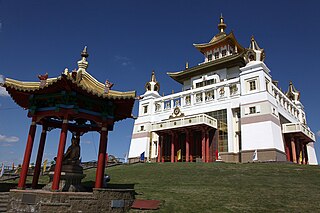
The Kalmyk people are the only people of Europe whose national religion is Buddhism. In 2016, 53.4% of the population surveyed identified themselves as Buddhist. They live in Kalmykia, a federal subject of the Russian Federation located in southwestern Russia. The border faces Dagestan to the south, Stavropol Krai to the southwest, Rostov Oblast to the west, Volgograd Oblast to the northwest and Astrakhan Oblast to the east. The Caspian Sea borders Kalmykia to the southeast.
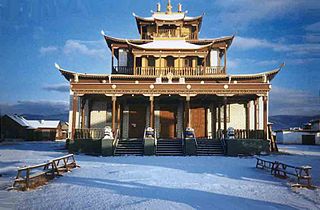
Datsan is the term used for Buddhist university monasteries in the Tibetan tradition of Gelukpa located throughout Mongolia, Tibet and Siberia. As a rule, in a datsan there are two departments—philosophical and medical. Sometimes to them is added the department of the tantric practices where the monks study only after finishing education in the philosophical department.

Agvan Lobsan Dorzhiev was a Russian-born monk of the Gelug school of Tibetan Buddhism, sometimes referred by his scholarly title as Tsenyi Khempo. He was popularly known as the Sokpo Tsеnshab Ngawang Lobsang to the Tibetans.

Gusinoye Ozero is a village (selo) in Selenginsky District of the Buryat Republic, Russia, located on the south-western shore of Lake Gusinoye, Selenga Highlands. Population: 3,268 (2002 Census); 4,219 (1989 Census). Gusinoye Ozero is the second most populated inhabited locality of Selenginsky District.

Historically, Buddhism was incorporated into Siberia in the early 17th century. Buddhism is considered to be one of Russia's traditional religions and is legally a part of Russian historical heritage. Besides the historical monastic traditions of Buryatia, Tuva and Kalmykia, the religion of Buddhism is now spreading all over Russia, with many ethnic Russian converts.
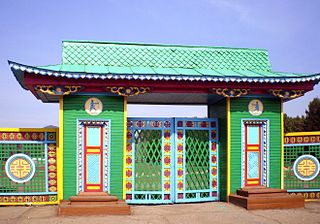
The Ulan-Ude Ethnographic Museum is an outdoor museum, located in the village Upper Berezovka, eight kilometres northeast of Ulan-Ude, Buryatia.

Bidia Dandaron was a major Buddhist author and teacher in the USSR. He also worked in academic Tibetology, contributed to the Tibetan-Russian Dictionary (1959) and made several translations from Tibetan into Russian. He is mostly remembered as a Buddhist teacher whose students in Russia, Estonia, Latvia, and Lithuania continued both religious and scholarly work, and as an early Buddhist author who wrote on European philosophy, history, and science within a Buddhist framework. Among his students were Alexander Piatigorsky and Linnart Mäll.
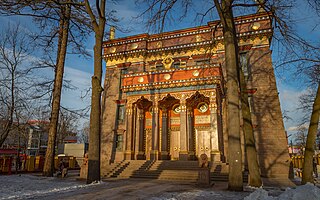
The Datsan Gunzechoinei is a large Buddhist temple in Saint Petersburg, Russia. It is the northernmost Buddhist temple in Russia.
A Khambo Lama is the title given to the senior lama of a Buddhist monastery in Mongolia and Russia. It is sometimes translated to the Christian title abbot.
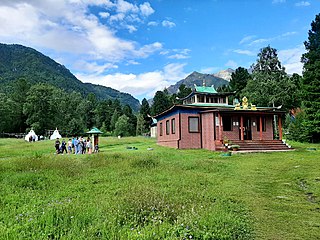
Arshan is a small resort village in the Tunkinsky District, Republic of Buryatia, Russian Federation. It is known for its mineral waters, spa, and the Khoymorski Datsan Boddhidharma Tibetan Buddhist temple. The name comes from the Buryat word for "spring."
Buddhism in Buryatia—a regional form of Buddhism.

The Tamchinsky datsan, also called the Tamchinskii datsan or Gusinoozyorsk Datsan, is a Buddhist monastery founded in the mid-18th century in the village of Gusinoye Ozero, located on the south-western shore of Lake Gusinoye, Buryat Republic, Russia.

Damba Badmaevich Ayusheev —the XXIV Pandito Khambo Lama—a Head of the Buddhist Traditional Sangkha of Russia.

Jampel Lodoy, also spelled with variations of Dzhampel Lodoi or Jambal Lodoi, was a Russian Tuvan Buddhist lama who served as the Kamby Lama of Tuva for two tenures. The Kamby Lama, or Supreme Lama, is the highest Buddhist religious authority in Tuva. Jampel Lodoy was first elected Kamby Lama from 2005 to 2010. During the 2010s, Jampel Lodoy became the abbot of Ustuu-Khuree, one of the largest Buddhist monasteries and temples in Tuva, which had been destroyed in 1937, but reopened in 2012.

A khurul is a Buddhist monastery in Kalmyk (Mongol-Oirat) Lamaism. Some of the most famous Kalmyk khuruls are the Burkhan Bakshin Altan Sume (contemporary) and the Khosheutovskiy Khurul.
References
- ↑ A History of Buddhism in Russia: The Sangha and the Soviets
- ↑ A History of Buddhism in Russia: The Sangha and the Soviets
- ↑ Buddhism in Russia
- ↑ Buddhism in Russia
- ↑ A History of Buddhism in Russia: The Sangha and the Soviets
- ↑ A History of Buddhism in Russia: The Sangha and the Soviets
- ↑ Buddhism in Russia